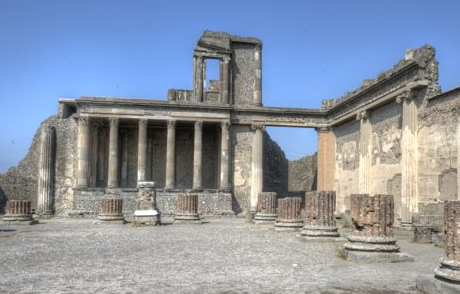What is the image and where would it have been found?
Lararium
Found in a home (specifically the House of the Vettii, Pompeii)
How many forums have been discovered in Pompeii and Herculaneum (where)?
TWO, both in Pompeii (the main forum and the triangular forum)
What is the name of the region in which the cities of Vesuvius are located?
Campania
What is the name for the open central public space of Roman house which is also the centre of religious and social activity?
Atrium
Who created the first plaster casts?
Giuseppe Fiorelli
The Capitolium is located in the forum. Which three gods are worshipped there?
Otherwise called the Temple of Jupiter – dedicated to Jupiter, Minerva, Juno, state religion
What is the name of magistrates who are responsible for maintaining public buildings and spaces?
Aediles
How many pyroclastic surges impacted Herculaneum?
Bonus 10 points for how many impacted Pompeii.
6 surges covered Herculaneum
Bonus 10 points - 4 arrived at Pompeii (a 5th one stopped just outside the Herculaneum gate)
What would be done in this location? (Bonus 10 points for correct name)/456044892.jpg)
Palaestra or exercise yard
Fill in the blank:
"Just when Pompeii was being rediscovered, it began to ... "
Henry de Saint-Blanquat
"Just when Pompeii was being rediscovered, it began to die it's second death"
Which two emperors were worshipped in Pompeii?
Vespasian and Augustus
What is the name and purpose of this building?
Basilica in Pompeii, its space was used to carry out business and for the administration of justice
Pompeii had about 2.5 metres of ash and pumice fall on it. How many metres of ash and pumice covered Herculaneum? (I’ll except a margin of 2 metres error)
23 metres
What is this called?
Triclinium
Name TWO issues facing conservationists in Pompeii and Herculaneum.
Insufficient finances
Lack of sufficient care in excavated parts
Unsympathetic restorations of the past
Nature; pests/animals, weeds, acid rain, sunlight, wear and tear
Human impact; negatives of humans (including tourism)
Drainage, Rising damp, Humidity
Who is this temple dedicated to and how does it link to another dot point?
Temple of Isis
Greek and Egyptian influences
This is an example of Electoral Graffiti
I beg you to elect Satrius quinquennial. (CIL IV 7620)
What is the correct term for this?
Programmata
Name FOUR features of the streetscape of Pompeii and Herculaneum
Pompeii has 9 regios
Herculaneum is only divided up into insulaes
Stepping stones were provided for pedestrians while still giving access to wheeled traffic
Deep grooves in the roads can still be seen, indicating the volume of ancient traffic.
The streets in Herculaneum had less traffic and more efficient drainage and sewerage systems.
Shrines and water fountains were often placed at these crossroads.
What is this item and its use?
Bonus 10 points if you know the latin term.
A Scraper or ‘Strigil’
Used to scrape sweat and dirt from the skin in a hot-air bath or after exercise
Name TWO way new technologies are impacting the conservation and preservation in Pompeii and Herculaneum.
X-ray phase-contrast tomography used on the Villa of Papyri scrolls
Scanning and restoration of 86 casts using computerised axial tomography (CAT) machines
Via dell’Abbondanza Project - Archaeologists have used state-of-the-art equipment to create photo mosaics of the entire 900 metres of the Via dell’Abbondanza
Digital photography and 3D imaging - University of Texas has created a fully navigable 3D model and reconstruction of the Villa of Poppaea at Oplontis in what is called the Oplontis Project.
Reflectance Transformation Imaging (RTI) is a new technology used primarily for graffiti and inscriptions at Pompeii and Herculaneum.
What is this building and where is it located?
College of Augustales
Located in Herculaneum
 Who is this (name, location and why was he significant)?
Who is this (name, location and why was he significant)?
Marcus Nonius Balbus - he was a prominent figure of Herculaneum during the Augustan period (27 BCE - 14 CE). He embellished the town with civic monuments and public facilities.
Name ONE 19th Century, ONE 20th Century and ONE 21st Century archaeologist from the cities of Vesuvius.
19th Century - Karl Weber, Giuseppe Fiorelli, August Mau
20th Century - Vittorio Spinazzola, Amedeo Maiuri, Wilhelmina Jashemski, Pietro Giovanni Guzzo, Sara Bisel
21st Century - Estelle Lazer, Andrew Wallace-Hadrill, Massimo Osanna
Explain the significance of this source.
Riot in the Amphitheatre fresco from the House of Actius Anicetus.
"About this time [AD 59] there was a serious fight between the inhabitants of two Roman settlements, Nuceria and Pompeii. It arose out of a trifling incident at a gladiatorial show....During an exchange of taunts—characteristic of these disorderly country towns—abuse led to stone-throwing, and then swords were drawn. The people of Pompeii, where the show was held, came off best. Many wounded and mutilated Nucerians were taken to the capital. Many bereavements, too, were suffered by parents and children. The emperor instructed the senate to investigate the affair. The senate passed it to the consuls. When they reported back, the senate debarred Pompeii from holding any similar gathering for ten years. Illegal associations in the town were dissolved; and the sponsor of the show and his fellow-instigators of the disorders were exiled."
Tacitus, Annals (XIV.17)
Where were the 2018 excavations located in Pompeii and what was their purpose?
Regio V and stabilisation work
Conservation work to stabilise more than 2.5km of ancient walls, while the un-excavated area behind the excavation fronts, in Regiones I-III-IV-V-IX, will be targeted by an intervention aimed at mitigating hydrogeological risk, ensuring adequate draining of the soil which will reduce the thrusting force of earth on the ancient walls, a particularly persistent problem in rainy periods.
The comprehensive intervention across all fronts of the ancient city will form part of the work of the Great Pompeii Project, and will last approximately two years, at a total cost of around €8.5 million.